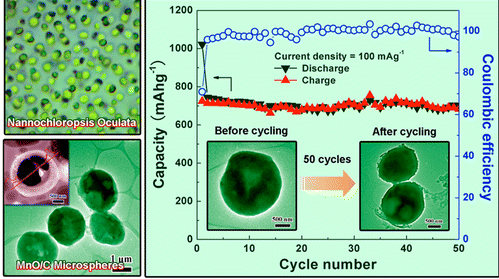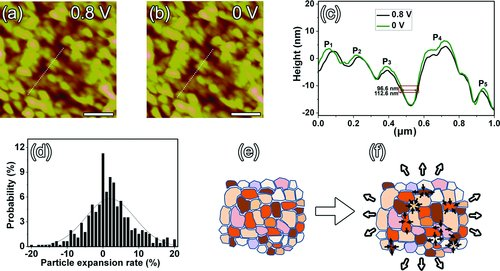- 研究成果
- 社会服务
1. Green and Facile Fabrication of Hollow Porous MnO/C Microspheres from Microalgaes for Lithium-Ion Batteries
作者:Xia, Y (Xia, Yang)[ 1 ] ; Xiao, Z (Xiao, Zhen)[ 2,3 ] ; Dou, X (Dou, Xiao)[ 1 ] ; Huang, H (Huang, Hui)[ 1 ] ; Lu, XH (Lu, Xianghong)[ 1 ] ; Yan, RJ (Yan, Rongjun)[ 1 ] ; Gan, YP (Gan, Yongping)[ 1 ] ; Zhu, WJ (Zhu, Wenjun)[ 1 ] ; Tu, JP (Tu, Jiangping)[ 2 ] ; Zhang, WK (Zhang, Wenkui)[ 1 ] 更多内容
ACS NANO 卷: 7 期: 8 页: 7083-7092 DOI: 10.1021/nn4023894 出版年: AUG 2013
摘要
Hollow porous micro/nanostructures with high surface area and shell permeability have attracted tremendous attention. Particularly, the synthesis and structural tailoring of diverse hollow porous materials is regarded as a crucial step toward the realization of high-performance electrode materials, which has several advantages including a large contact area with electrolyte, a superior structural stability, and a short transport path for Li+ ions, Meanwhile, owing to the inexpensive, abundant, environmentally benign, and renewable biological resources provided by nature, great efforts have been devoted to understand and practice the biotemplating technology, which has been considered as an effective strategy to achieve morphology-controllable materials with structural specialty, complexity, and related unique properties. Herein, we are inspired by the natural microalgae with Its special features (easy availability, biological activity, and carbon sources) to develop a green and facilebiotemplating method to fabricate monodisperse Mn0/C microspheres for lithium-Ion batteries. Due to the unique hollow porous structure in which MnO nanoparticles were tightly embedded into a porous carbon matrix and form a penetrative shell, Mn0/C microspheres exhibited high reversible specific capacity of 700 mAh g(-1) at 0.1 A g(-1), excellent cycling stability with 94% capacity retention, and enhanced rate performance of 230 mAh g(-1) at 3 A g(-1). This green, sustainable, and economical strategy will extend the scope of biotemplating synthesis for exploring other functional materials in various structure-dependent applications such as catalysis, gas sensing, and energy storage.

全文链接:http://pubs.acs.org/doi/abs/10.1021/nn4023894
2. Exploring the Energy Storage Mechanism of High Performance MnO2 Electrochemical Capacitor Electrodes: An In Situ Atomic Force Microscopy Study in Aqueous Electrolyte
作者:Tao, XY (Tao, Xinyong)[ 1 ] ; Du, J (Du, Jun)[ 1 ] ; Sun, Y (Sun, Yong)[ 2 ] ; Zhou, SL (Zhou, Shulan)[ 3 ] ; Xia, Y (Xia, Yang)[ 1 ] ; Huang, H (Huang, Hui)[ 1 ] ; Gan, YP (Gan, Yongping)[ 1 ] ; Zhang, WK (Zhang, Wenkui)[ 1 ] ; Li, XD (Li, Xiaodong)[ 2 ]
ADVANCED FUNCTIONAL MATERIALS 卷: 23 期: 37 页: 4745-4751 DOI: 10.1002/adfm.201300359 出版年: OCT 4 2013
摘要
The basic microstructure-dependent charge storage mechanisms of nanostructured MnO2 are investigated via dynamic observation of the growth and in situ probing the mechanical properties by using in situ AFM in conjunction with in situ nanoindentation. The progressive nucleation followed by three-dimensional growth yields pulsed current deposited porous nanostructured -MnO2, which exhibits a high specific capacitance of 437 F/g and a remarkable cycling performance with >96% capacitance retention after 10 000 cycles. The proton intercalation induced expansion of MnO2 can be self-accommodated by the localized compression and reduction of the porosity. More coincidentally, the proton intercalation induced softening is favorable for the elastic deformation of MnO2. This self-adaptive capability of nanostructured MnO2 could generate high structural reliability during cycling. These discoveries offer important mechanistic insights for the design of advanced electrochemical capacitors.

全文链接:http://onlinelibrary.wiley.com/doi/10.1002/adfm.201300359/full



